If you are a marketing professional, there’s a good chance that you’ve been taught that the four P’s (price, product, promotion, and place) should form the basis of any marketing campaign. But that mindset isn’t built for a digital world and the changing expectations of consumers.
That’s why, if you walk into a marketing classroom today, you’ll find there is a new set of first principles of marketing built for this new era, formulated as four essential truths:
- All customers differ
- All customers change
- All competitors react
- All resources are limited
In a digital-first world, things move a lot faster, and it’s not enough to just sell a product by listing all of its features or offering the most competitive price. You need to consider factors like consumer behavior, personalization, a wide variety of channels, and an ever-growing field of competition. In other words, you need a potent combination of data and strategy to light the way.

So let’s dig into each of the principles and learn how they can help reorient your marketing mindset to build better strategies.
All customers differ: the critical need for smart audience segmentation
Your audience should be at the center of your media planning: you need to understand how they’re consuming media, what they expect from brands, and what drives them to consider a brand in different media environments. All of these differing needs, perceptions, perspectives, and behaviors need to become points of data that form the foundation of your marketing strategy, including media mix and budgeting decisions.
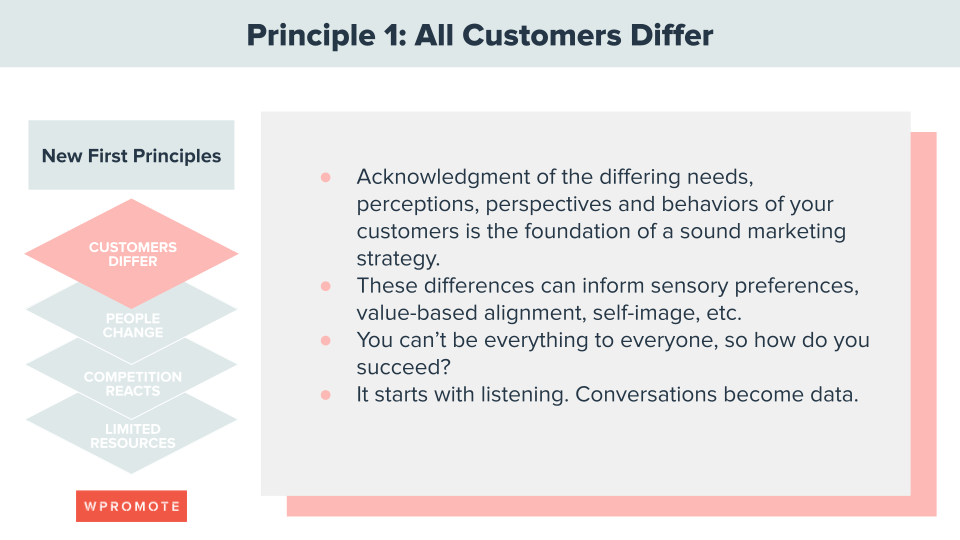
That’s where audience segmentation comes into play; to effectively segment your audience, you’ll need to bring together various kinds of consumer intelligence to glean insights and inform marketing decisions, then translate that intelligence into activation in your marketing channels.
The first step is combining your first-party behavioral data with insights into larger consumer trends to identify and prioritize key groups of customers, creating meaningful cohorts based on your core audience and opportunity audiences you can optimize against. Look to build out specific audience segments that include at least 5,000-10,000 people. You should look to separate your core audience from new opportunity audiences, then prioritize your efforts based on LTV.
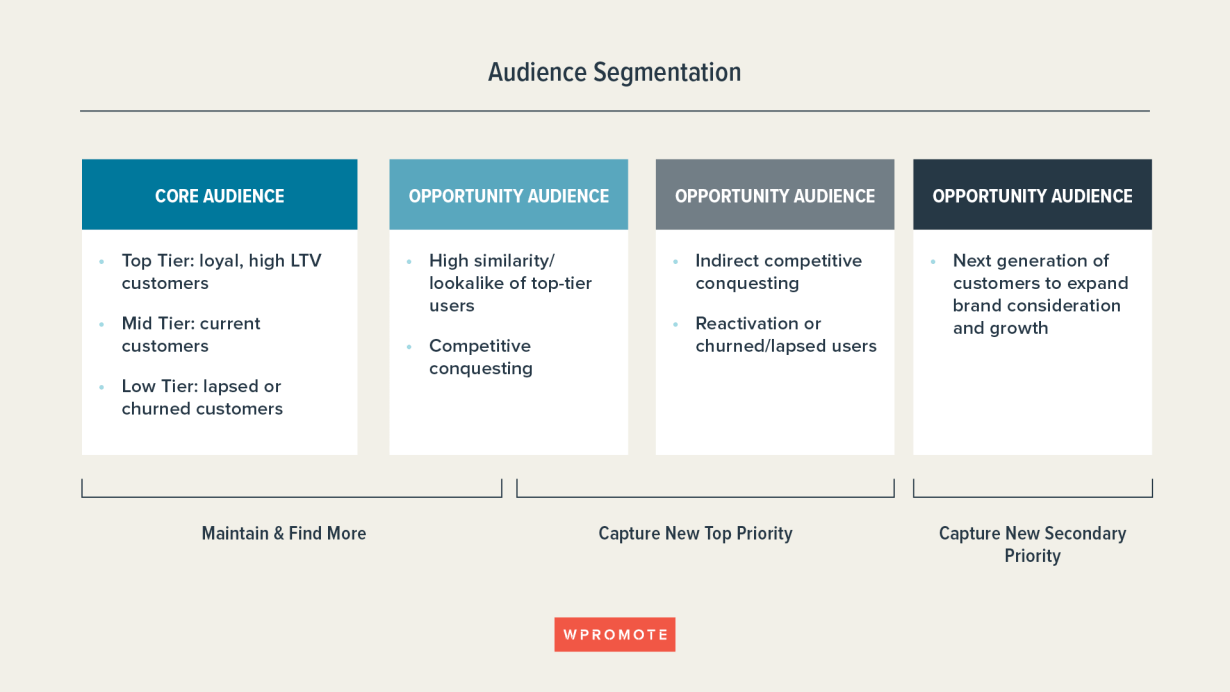
Look to leverage privacy-compliant technology like a CDP to create a structure that accounts for all stages of the consumer lifestyle: consumer → customer → retention → evangelist → churned. That will help you get a really strong pulse on what these buckets are and how many people exist in them at any given time. The goal is to better understand what the broader market looks like and how your brand can transform consumers into customers, then maximize LTV for your most valuable segments.
That will give you access to a powerful audience framework that can get you through the turbulent changes in the marketing industry around privacy and platform fragmentation as well as setting the stage for personalization.
Think of the sweet spot for your cohorts as somewhere between 25,000-200,000 people; more than that indicates you should segment further. Make sure you’re applying proper data taxonomy and appropriate tagging to your new audience segments so you can accurately measure performance and continue to gather fresh insights into their specific behavior to inform your strategy.
Segments that have reached the 5,000-10,000 person minimum should be piped into your paid media channels. You can then start serving them ads about your brand based on the information you’ve gathered, utilizing creative and messaging that speak directly to their needs.
All customers change: agility is a make-or-break part of your marketing strategy
People’s relationship with a brand isn’t static; your customers will have different needs as they transition from learning about your brand to first-time buyer to loyal customer. Customer preferences are also dynamic, shifting as new styles, economic factors, personal tastes, life events, and more continue to change.
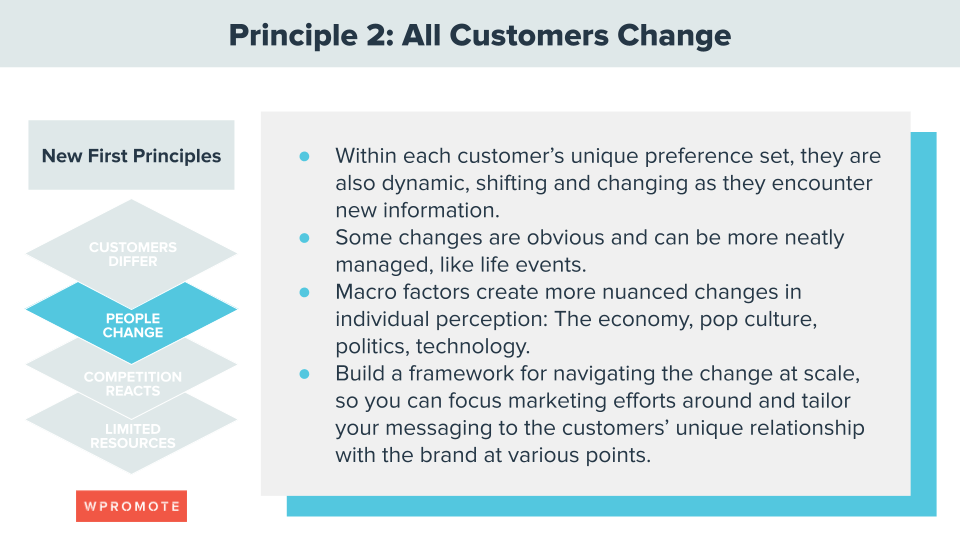
The key to unlocking agility is information. Internally, you should pay close attention to shifts in the news and industry trends as well as any shifts in purchase behavior specific to your business and prepare to re-prioritize in response.
To get that information, you need a single source of truth where you can combine first-party data points about your customers’ patterns of behavior and how they’re changing with consumer and industry insights. Then you can pull those learnings into audience segments to get more information about what specific groups need and how your brand can deliver solutions across an integrated media mix.

Look to establish a center of excellence for all media so you can consider how different platforms can work for your business without bringing a lot of preexisting assumptions to the table. Follow the data and your customers to the right channel mix to maximize brand growth and share of voice while driving performance.
You can then quickly move spend to adjust, adapt, and test into new opportunities generated from larger trends like inflation or new social channels. You can build new campaigns to address life changes or broader behavioral preferences. Then you can tailor your messaging and offerings to make sure you’re meeting customer needs as effectively as possible at that point in time.
All competitors react: responsiveness is key, but don’t lose what makes your brand distinct
As consumers and market conditions change, competitors will react, sometimes in surprising ways. Agility isn’t just about adjusting messaging, it’s about how quickly your marketing change can respond to what’s happening in real time. But you have to make sure you don’t throw the baby out with the bathwater in the name of agility; you need to understand what makes your brand different and what about your positioning speaks to your customers and take that into account, even through chaotic periods of change.

When it comes to reacting to new competitors in the market who might be capturing market share, don’t panic. Be careful of making decisions that lose what’s distinct about your own offering. Look no further than Instagram’s response to the rise of TikTok: the video started taking audiences away from other social media platforms like Instagram, so Instagram launched Reels, which was criticized for aping TikTok’s features.
In fact, other changes Meta announced that would make Instagram even more similar to TikTok have been postponed after widespread outcry to “Keep Instagram Instagram.” And despite all of Meta’s efforts, TikTok users are still spending more time on TikTok than Instagram.
Make sure you consider three critical components of your competitive advantage when deciding how to react to market changes:
- Your brand: what do you stand for?
- The customer experience: are you aligning the product or service experience with what you know about people’s preferences and behavior?
- Your company culture: are cultivating an appetite for calculated risk and innovation?
On social media channels, for example, costs rose in 2022 because of stronger competition in tandem with performance issues stemming from bigger changes like inflation and privacy challenges. Adapting your approach and how you’re spending your budget to follow demand and allow for continued experimentation is key.
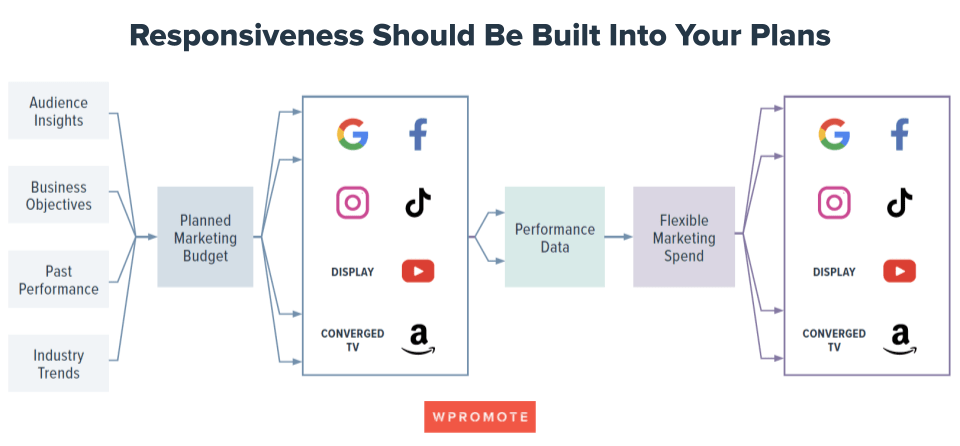
You should of course keep an eye on the competition, but first and foremost you need to set your own course that builds agility into your strategy. That doesn’t mean just doing what you’ve always done, it just means choosing when to react and having the right mechanisms, namely technology and expertise, in place to help you choose the best course for your brand, your business outcomes, and your customers.
That’s especially true in a potential recession: many brands will cut their budgets, but that’s good news for smart leaders who aren’t just following the pack. Recessions actually represent a major low-cost growth opportunity for businesses that don’t get in their own way, because many competitors will either leave the field or minimize their efforts.
Leaders that recognize that chance and put their money in the right places will come out the other side leaps and bounds ahead of their peers and positioned to widen that gap. Your media dollars will go further with less competition in play, and if you’ve invested in the right data capabilities, they’ll also drive better performance in the short and long term.
All resources are limited: your marketing efforts need to align with business outcomes
Organizations of every size experience resource limitations, which means even brands that dominate their categories need to learn how to outsmart, not just outspend the competition. Measuring marketing performance isn’t enough, especially if your goal is to achieve profitability. You can’t be everywhere, so you need to understand how marketing investments impact business outcomes to get the most out of limited budgets.
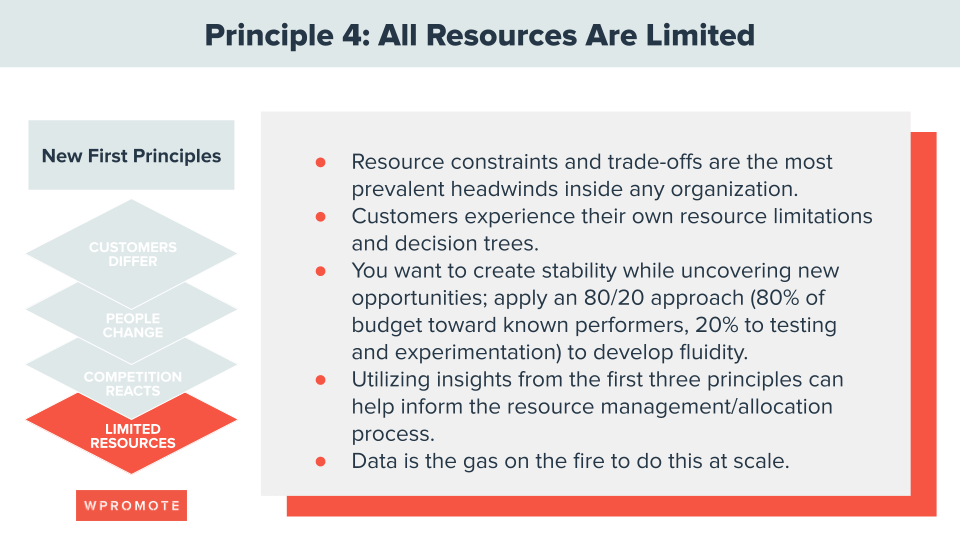
There are two critical tools to better align your marketing efforts with business outcomes: media mix modeling and incrementality testing. Both serve to provide a better understanding of how marketing really impacts the core objectives of your business, beyond vanity metrics or platform-specific performance.
To really understand the value of your marketing investment to the business as a whole, you need to be able to see the performance data across all of your media efforts in a holistic view. After all, the customer doesn’t see channels, and channel performance alone isn’t the endgame, it’s overall business growth. A functional media mix model provides a clear picture of how each platform and each initiative within those platforms impacts the overall business so you can understand where users are engaging as part of that journey, where you are over-indexing, and where you are under-indexing.

Wpromote’s own high-velocity mixed media model Growth Planner, part of our Polaris tech platform, models returns across all paid media and offline channels so our experts can create actionable plans to optimize budget investment or achieve a target revenue goal. That means we can understand how changes in investment, like increases or decreases in spend on a specific platform or even on a specific initiative, affect the overall business-level results. It also tells us how to invest down to the specific tactic, down to the channel, month, week, and day, so we can ensure that we are putting your media dollars in the right place and supporting our clients’ business goals.
This type of modeling is incredibly important because it provides a very clear roadmap that highlights opportunities for incremental investment. We can decide where that next best dollar should be spent and the effect that it’s likely to have on the business as a whole.
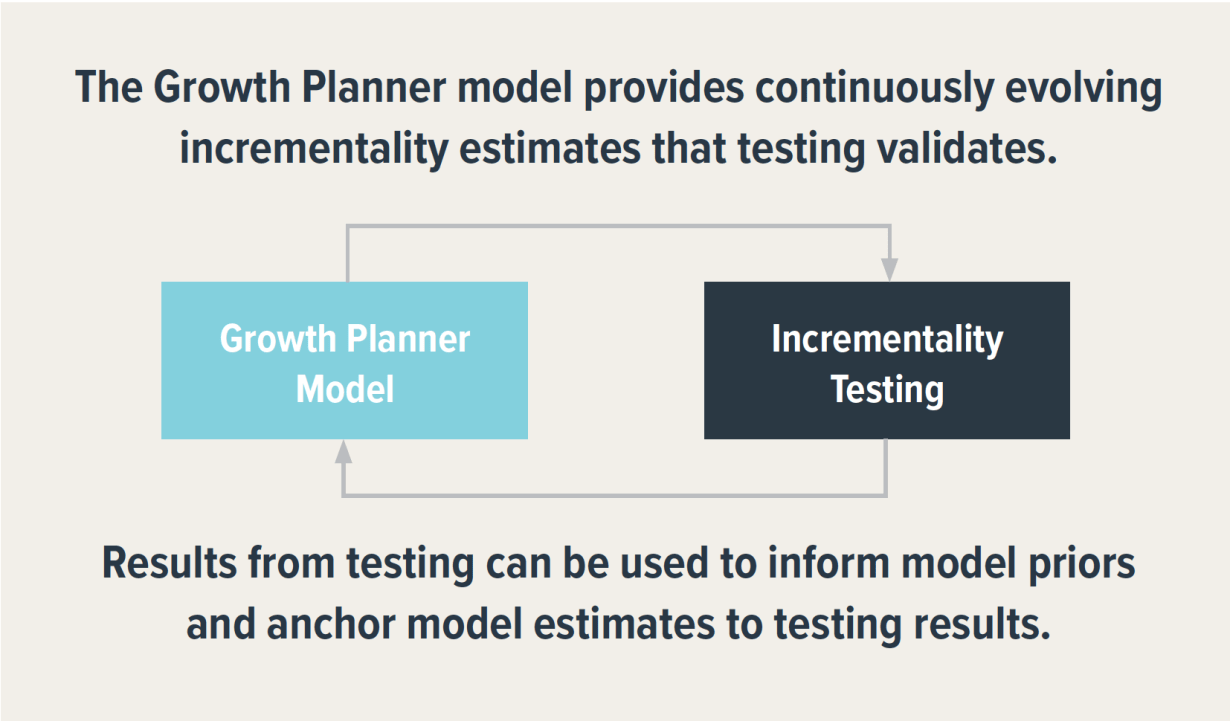
Incrementality refers to the actual impact of your marketing campaigns, i.e. solving for how many conversions occur because of your ads by removing the conversions that would have happened anyway. Think about it like this: if someone is served an ad on Google and makes a purchase, Google will attribute the sale to your ad. But what if that person was already going to buy? You’re not getting a totally accurate view of the impact your ads are having without removing those conversions.
That’s why incrementality testing is more important than ever as we increasingly rely on models and it gets harder to understand cross-channel influence and attribution. Robust incrementality testing can help you both validate modeled performance data and get a clearer picture of how your campaigns are affecting the full customer journey.
The basic approach to incrementality testing has four steps:
- Define your testing goal and hypothesis, and which KPIs are relevant: What do you want to know? What do you believe will happen? Which metrics are relevant to answering the question?
- Segment your audience into a control group (who won’t see your ad) and a randomly selected test group (who will receive an ad). You need to have a statistically significant number of people in each group to get meaningful results, and the two groups should be as similar as possible.
- Set the parameters of your test, including timing and duration. For more complex tests involving multiple variables, you need a data scientist on hand to ensure you’ll get actionable results.
- Analyze your results! The simplest version of this analysis is to subtract the control group conversion rate from the test group conversion rate, then divide it by the test group conversion rate. Basically, there are three potential results: positive incremental lift, neutral incremental life, and negative incremental lift.
To make the most of your budget, you need strategies that speak to your customers, change with the times, and stay ahead of the competition. You also need to be able to incorporate new technology and innovation into your efforts, especially when it comes to evaluating whether or not your campaigns working to help you achieve your business outcomes. That’s what these four principles can help you keep front of mind.







Responses